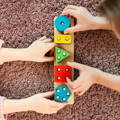Montessori Toy Design: The Intersection of Aesthetics and Functionality
The Montessori method is gaining popularity today for its relaxed and nurturing approach to child development. And, in the center of this parenting approach are the Montessori toys.
These toys are designed in a special way, a way that focuses on the child’s development and enables them to learn through play. The mantra "follow the child" is central to this philosophy, particularly in play, where open-ended toys allow kids to lead their own learning.

So, today, we’ll explore Montessori toy design, emphasizing the balance between aesthetics and functionality. Let’s learn the science behind these toys and see why they are designed in such a simple way.
Montessori Psychology Behind Toys
Dr. Maria Montessori, the founder of the Montessori method of learning, created a set of principles that we use today in teaching and parenting. Those principles are also tied to the design of Montessori toys.
Let’s learn more about them:
- Independence: The Montessori method encourages independence by letting children do things on their own. Related to toys, the design supports self-learning and confidence, letting children handle tasks independently.
- Following the child: This method suggests that following a child's lead and supporting their natural curiosity is crucial. Therefore, toys are picked based on children's interests, allowing them to choose and act independently.
- Correcting process: The Montessori method suggests calm correction over criticism, providing learning opportunities. And that’s why these toys allow children to learn through trial and error, correcting mistakes without the fear of criticism.
- Prepared environment: In Montessori, the environment is crucial for children's education. In that light, toys are part of a prepared environment specially created for successful learning, encouraging freedom of movement and choice.
- Absorbent mind: The Montessori learning method acknowledges that young children naturally absorb their environment. So, toys are selected to contribute positively to that.

As you can see, Montessori toys follow these principles to allow children to learn as they play. Exploring the world around them, our kids learn to solve problems, use their imagination, and, most importantly, do all that independently.
Aesthetics in Montessori Toy Design
Montessori toys are designed with huge attention to detail regarding their looks. Children should be ‘’invited’’ to play with a toy. If a toy is not exciting, kids won’t play with it, simple as that.
That’s why looks matter a lot in Montessori toys: when the child interacts with the toy, they should look forward to exploring its features. For example, the Montessori Magnetic Maze features a colorful animal-shaped design (e.g., owl, monkey, frog, etc.). These are some of the themes kids find most exciting.

In that way, Montessori toys are fun and engaging. Using colors, textures, shapes, and other details is vital in catching children’s attention. Only later does the toy's functionality come into play.
Why Are Montessori Toys Interesting?
It’s because they are simple, easy to play with, and engaging. Most Montessori toys are open-ended in nature, meaning children can play with them in more than one way.
1. Simplicity: The Montessori approach to toy design prioritizes simplicity over complexity. Simple designs capture a child's attention, helping them focus and connect more deeply with the toys.
2. Natural materials: This learning method puts an accent on natural materials like wood, fabric, and cardboard. Eco-friendly Montessori toys not only offer a sensory experience but also align with the Montessori philosophy, connecting children to the natural world.
3. Open-ended play sparks creativity: Open-ended play is one of the key aspects of the Montessori method. It enables children to practice problem-solving and decision-making all on their own.
Clearly, the simplicity catches the attention, natural materials provide a sensory experience, and open play sparks creativity - Montessori toys are both fun and valuable assets to have in your playroom.
Functionality in Montessori Toy Design
The idea of designing a toy that intentionally focuses on one aspect of development is what drives Montessori toys. Namely, the functionality of these toys is carefully considered to enable children to learn while they play.
One of the most important aspects of Montessori toys is the purpose-driven design. This type of design ensures that toys have a clear purpose and contribute to skill development. For example, the Montessori Wooden Tetris is a great toy that invites your child to learn to sort and arrange things by shape and color.

This kind of play enables them to use logic in real life. Sooner or later, your child will grasp the concept of this toy, which will improve their memory, attention span, and problem-solving capabilities.
What Skills Do Montessori Toys Enhance?
Montessori toys help children develop problem-solving, logic, and fine and gross motor skills and contribute positively to their intellectual development. They are also great for developing cognitive abilities, even from the early stages of life.
So, Montessori toys help children develop:
1. Critical thinking: The design of Montessori toys encourages thinking and analyzing situations. By fostering open-ended play and problem-solving, these toys promote critical thinking skills in children.
2. Decision-making abilities: Montessori toys push children to make decisions from an early age. Engaging with Montessori toys, particularly those with purpose-driven designs like Montessori Happy Puzzles, contributes to developing decision-making skills.
3. Memory skills: This method of education recognizes the importance of memory in the learning process. Specially designed Montessori toys that require memory recall are able to improve the children’s overall memory. The perfect example is the Montessori Memory Match.
4. Coordination and movement: The Montessori method nurtures the connection between physical coordination and overall development. Toys involving hands-on activities improve hand-eye coordination.

Conclusion:
In light of everything we said above, Montessori toys are a great choice because they're not just fun; they also help kids learn and grow in many ways.
These toys are simple, made from natural materials like wood, and exist to allow children to learn through play.
These toys help kids think better, solve puzzles, remember things, and even improve their hand movement. It’s as simple as that!
Free Delivery
Over $80
Easy Returns
No questions asked
Unbeatable Warranty
1-year ++ warranty
- Secure CheckoutWorld’s most secure payment method




